I find it fascinating how Cordyline australis transforms as it becomes older. It starts off with just one trunk and a small bunch of leaves on top. As it establishes itself, it can create new trunks and each has its own set of leaves. This natural design makes for a visually pleasing tree.
In our cabbage tree guide, we’ll go through some popular varieties and what colours you can expect from each. Learn how to propagate your own tree, how to care for it, and what pests and diseases to be aware of.
More...
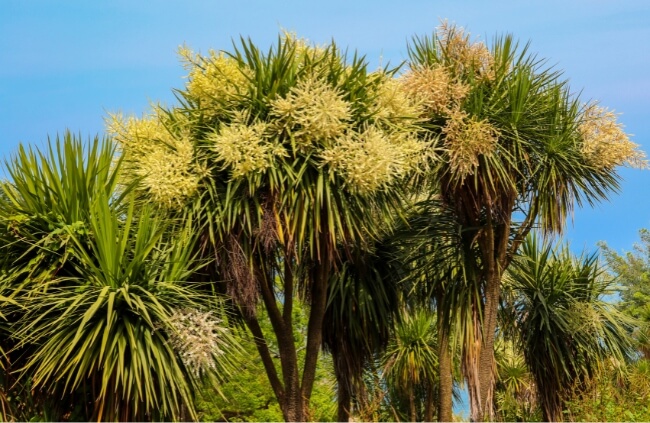
Family: | Asparagaceae |
|---|---|
Genus: | Cordyline |
Species: | C. australis |
Common Names: | Cabbage tree, New Zealand Cabbage Tree |
Origin: | New Zealand |
Location: | Indoor and outdoor |
Type: | Tree |
Growth: | Up to 6 metres tall and 3 metres wide |
Sun requirements: | Full or partial sun |
Foliage Colour: | Varies depending on cultivar |
Flower Colour: | White |
Flowering: | End of spring to early summer |
Edible Parts: | Leaves and roots |
Maintenance level: | Low |
Poisonous for pets: | Yes |
Introduction to Cordyline australis
Cordyline australis is an evergreen tree that originates from New Zealand and looks very much like a palm. Cabbage trees have a bold and exotic look once they have matured, making them a much loved choice for Australian gardens.
There are various cultivars of Cordyline australis and so the leaves can be various shades from green, red, and purple, to yellow with stripes that are either pink or white.
The cabbage tree is hardy and produces a display of fragrant flowers during summer. After the flowers, the tree produces white berries. If you are hoping to create a tropical feel in your garden, Cordyline australis works well. It also suits a smaller garden and you can grow it in pots too.
Cordyline australis Varieties
Cordyline australis ‘Green Star’
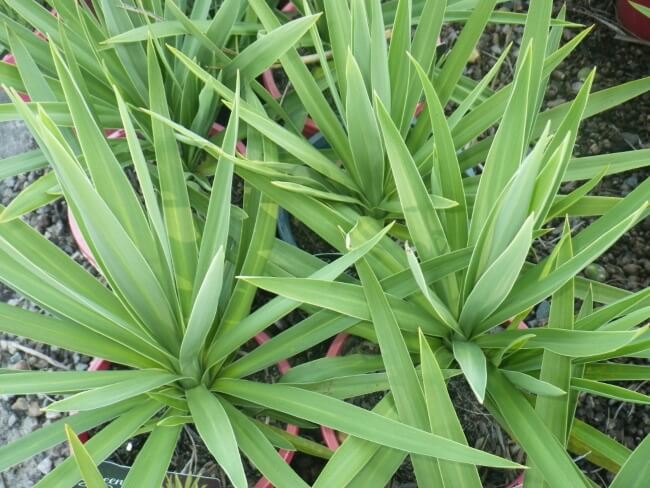
Landsdale Plants Perth
This is a dwarf variety that has leaves which are green, glossy, and strappy. It does well in various climate types, growing to a height and width of around 1 metre. It will be happiest growing in part or full shade.
Cordyline australis ‘Red Sensation’
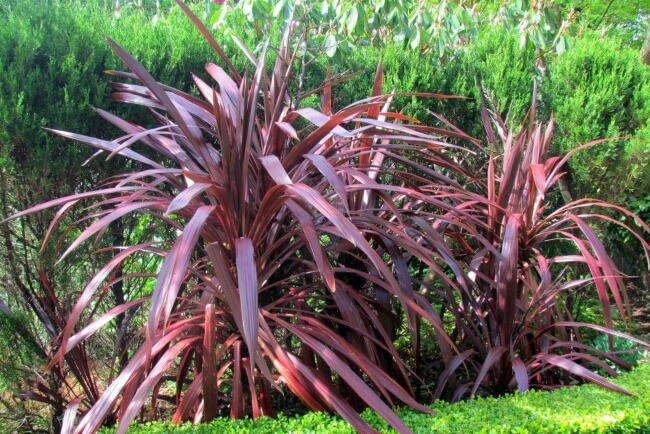
Dapple Landscape Design
This variety has big leaves which are a purple to red colour. It has an upright growth and creates a few different heads as it matures. It is hardy and grows well in pots.
Cordyline australis ‘Red Star’
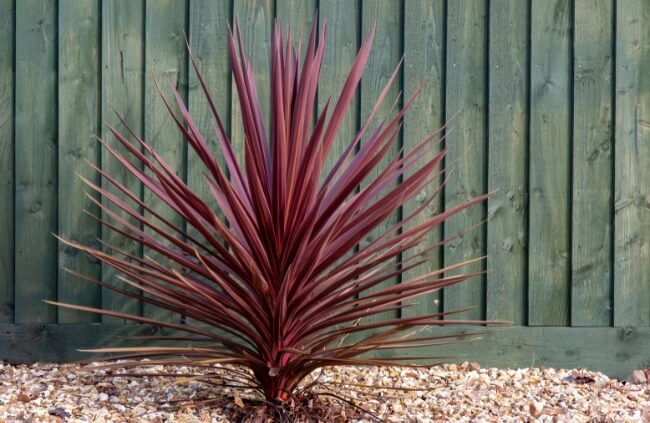
This variety has leaves that are more slender than the Red Sensation, similar to a sword shape. The leaf colour is more red than purple with a green edging. The tree size is about 2.5 metres in height and 1 metre wide.
Cordyline australis ‘Sundance’
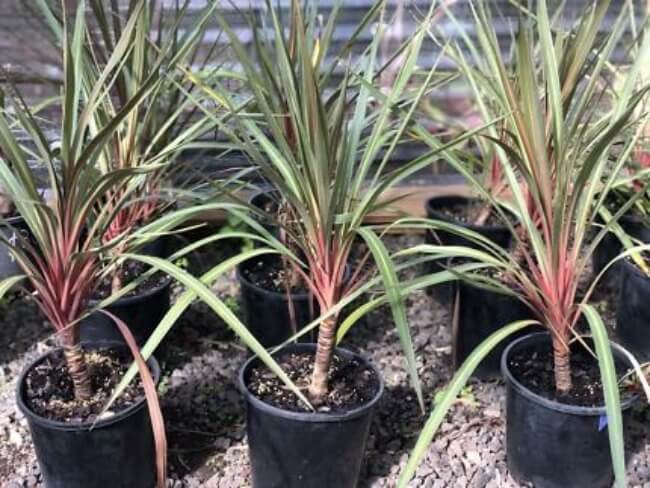
True Green Nursery
This variety has gold leaves that have streaks of copper and pink. It produces a small trunk and as it matures, can grow others. The size of the tree is about 2.5 metres high and 2 metres wide.
Cordyline australis ‘Green Star’This is a dwarf variety that has leaves which are green, glossy, and strappy. It does well in various climate types, growing to a height and width of around 1 metre. It will be happiest growing in part or full shade. |  Source: Landsdale Plants Perth |
Cordyline australis ‘Red Sensation’This variety has big leaves which are a purple to red colour. It has an upright growth and creates a few different heads as it matures. It is hardy and grows well in pots. |  Source: Dapple Landscape Design |
Cordyline australis ‘Red Star’This variety has leaves that are more slender than the Red Sensation, similar to a sword shape. The leaf colour is more red than purple with a green edging. The tree size is about 2.5 metres in height and 1 metre wide. |  |
Cordyline australis ‘Sundance’This variety has gold leaves that have streaks of copper and pink. It produces a small trunk and as it matures, can grow others. The size of the tree is about 2.5 metres high and 2 metres wide. |  Source: True Green Nursery |
How to Grow Cordyline australis
Cabbage trees thrive in coastal areas and anywhere that has decent rainfall. It can handle some frost and dryer areas if it gets regular water. Provide your tree with well-draining soil and either full sun or partial shade.
Propagating Cordyline australis
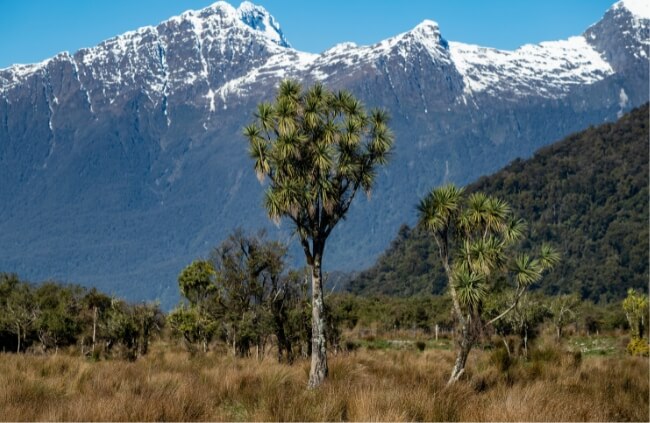
How to Propagate Cordyline australis from Cuttings
You can propagate your own Cordyline australis using cuttings that are taken at the end of spring or the beginning of summer. When you have the pots you’re going to use, add a potting mixture as well as sand and perlite.


Get Your Free Guide:
Master Growing Australian Natives eBook
A Must Have Complete Guide for Every Australian Garden
Get Your Free Guide:
Master Growing Australian Natives eBook
A Must Have Complete Guide for Every Australian Garden
Give the mix enough water so it feels damp. Look for a branch that is brown and mostly bare close to where it attaches to the tree and that is green with some leaves at the other end. You can make a cutting that is about 6 cm and it’s important that it has leaf nodes.
Once you have your cuttings, dip the cut end into some fungicide powder and then plant it in the prepared pot so that only half the stem sticks out of the potting mixture. Place the pot somewhere warm with indirect sunlight. You can water every few days to make sure the soil doesn’t dry out.
It takes between 4 and 8 weeks for shoots to appear and once you see these, you can slowly allow the plant to get increased light exposure and to water less often, but provide more water at each watering. When the plant is ready, it can be moved to a bigger container with compost added.
Cabbage Tree Propagation from Seeds
You can begin this process during autumn or winter. Sow the cabbage tree seeds in compost that is well-draining and then lightly cover them. Once the shoots are around 5 cm in height, you can move them into individual pots.
Use the springtime to allow for a period of hardening off, and then you can move your new plants outside. They will need some protection during their first winter so try and move them undercover.
Ideal Conditions for New Zealand Cabbage Tree
Planting Location
You can plant your Cordyline australis in full sun or partial shade.
What Soil to Use
Luckily, the cabbage tree is quite easy when it comes to soil requirements. They will do best in a well-draining and rich soil and you can add some compost into the soil when you plant. Cordyline australis doesn’t like to sit in water so aim to plant it in a raised position in the garden. This will help with drainage.
Watering Cordyline australis
We recommend regular watering for your Cordyline australis when it goes through its first summer and once the plant is more established, it then becomes drought tolerant.
If your plant is being grown in a pot, you will need to water it often during the growing phase but in the winter time you can keep it drier, especially if indoors. For cabbage trees grown outside, they will need protection from large quantities of rain during winter.
What Fertiliser to Use
If you are growing Cordyline australis in the garden, you won’t need to fertilise. For plants grown in a pot, you can feed with a balanced liquid fertiliser during spring and summer. If you use a fertiliser with a high potassium content, it actually makes the leaves brighter.
Pruning Cordyline australis
When it comes to pruning Cordyline australis, it’s not a must. You can of course opt to prune if you want to keep the tree looking neat and tidy or get rid of any winter damage. If it becomes too big, you can prune your cabbage tree during spring by cutting through the main stem.
It’s best to cut above a shoot on the side or at the ground surface. Cabbage trees do shed their older leaves over time so you can get rid of these too and any flowers that have expired.
Common Cordyline australis Pests and Diseases
Mealybug
These pests damage your tree when they suck the juices from the plant. They are tiny and thrive particularly in warmer weather, producing a waxy protective coating.
When it comes to dealing with mealybugs, you can use a strong spray of water to knock them loose if you are dealing with a light infestation. Isopropyl alcohol on a cotton ball can be used to wipe the mealybugs off the plant and it kills them. You can do this same treatment every week until the infestation has cleared up.
Alternatively, make your own insecticidal soap using a teaspoon of dish soap in 3, 8 litres of water and then spray the entire plant. You can do this twice a week to treat the infestation. Neem oil also works wonders.
This organic insecticide can be mixed with dish soap and warm water to create a spray to be used morning and night. Neem oil inhibits the growth and development of mealybugs and helps to repel them.

Scale
Scale can differ in its shape, size and colour, which can be anything from white to black to orange. Once they have latched onto your plant, they are quite firmly stuck. You would usually see a collection of little bumps, almost like shells, on the leaves and stems of your plant as they happily suck the sap.
When it comes to treatment, one of the simplest ways to deal with an infestation is to prune off the affected parts of your plant or tree. Rubbing alcohol also works for lighter infestations. You can use a cotton bud dipped in the alcohol to apply directly to the bugs.
To make the process go a bit quicker, you could fill a spray bottle with one part alcohol to seven parts of water, and then apply generously as a spray. You can repeat the process every few days as needed.
Neem oil is such a great insecticide as its main ingredient is fantastic at keeping scale away and killing off any existing infestations. You can add the oil to some dish soap and water and then apply with a spray bottle.
You can use a recipe of 2 teaspoons of dish soap, 2 tablespoons of oil, and 4 litres of water.
Spider mites
Spider mites love to feast on a plant’s leaves and help themselves to its sap. Certain types of spider mites can inject the leaves with toxins which makes them change colour and take on an odd shape.
Look out for white webs on the leaves, as well as leaves that are becoming yellow or have yellow spots on them. You might also find white spots and leaf drops. You can’t actually see spider mites as they are so tiny. If you place a piece of paper under the leaves and tap them lightly, you might knock off some of the mites and then be able to see them using a magnifying glass.
Rubbing alcohol works well to kill spider mites. You can mix up a cup of rubbing alcohol and 4 cups of water to create a spray for your tree. The alcohol dehydrates the pests and kills them off. You can use a strong spray of water to knock the pests off the plant.
You’ll need to repeat this method often to keep any spider mite colonies under control. Once again, neem oil is a great insecticide which helps to stop feeding and egg-laying of the mites.
Cordyline australis Frequently Asked Questions

How long can a cabbage tree live for?
Cordyline australis is considered a long living tree, which under the right growing conditions, can live up to 400 years.
What are some of the uses of Cordyline australis?
The leaves of the cabbage tree are incredibly strong and decompose slowly, making them a popular choice for making rope. The dead leaves are great fire kindling.
Can you eat Cordyline australis?
The arrangement of new leaves that emerge (that look much like a cabbage) can be eaten but are quite bitter. The roots are packed with carbohydrates and if cooked for long periods of time, produce a sugar that can be eaten. This provided a valuable source of food for M?ori in New Zealand.
Does Cordyline australis have any special meaning or significance?
Yes, it is an important cultural symbol for the Maori people of New Zealand. They have used it for centuries, creating baskets and clothing from the leaves and fishing line or rope from the bark. The cabbage tree is often used in ceremonies in Maori culture to symbolise resilience and survival.
Is Cordyline australis drought tolerant?
Cabbage trees are able to survive with very little water as they can store water in their leaves and stems.
What kind of fertiliser is best for my cabbage tree?
Aim for a fertiliser that has nitrogen, phosphorus, and potassium. Depending on the cultivar you have, you could opt for a liquid fertiliser which helps promote growth, or otherwise a slow-release fertiliser to provide sufficient nutrients.
Does Cordyline australis have an invasive root system?
The root system of the cabbage tree can spread out quite a bit which means you’ll need to choose your site carefully. If you’re growing it in a pot, it needs to be big enough for an expanding root system to avoid the plant becoming distressed.
Sign up for our newsletter to receive reviews, gardening advice, and plenty of green inspiration.
Wrapping Up Our Cordyline australis Growing Guide
Cordyline australis is a wonderful ornamental tree and has earned itself popularity in landscapes the world over. The hardy nature of the cabbage tree and its ability to absorb carbon dioxide and release oxygen, makes it a highly recommended choice for the Australian garden.
Published on October 23, 2023 by Maisie Blevins
Last Updated on February 25, 2024




